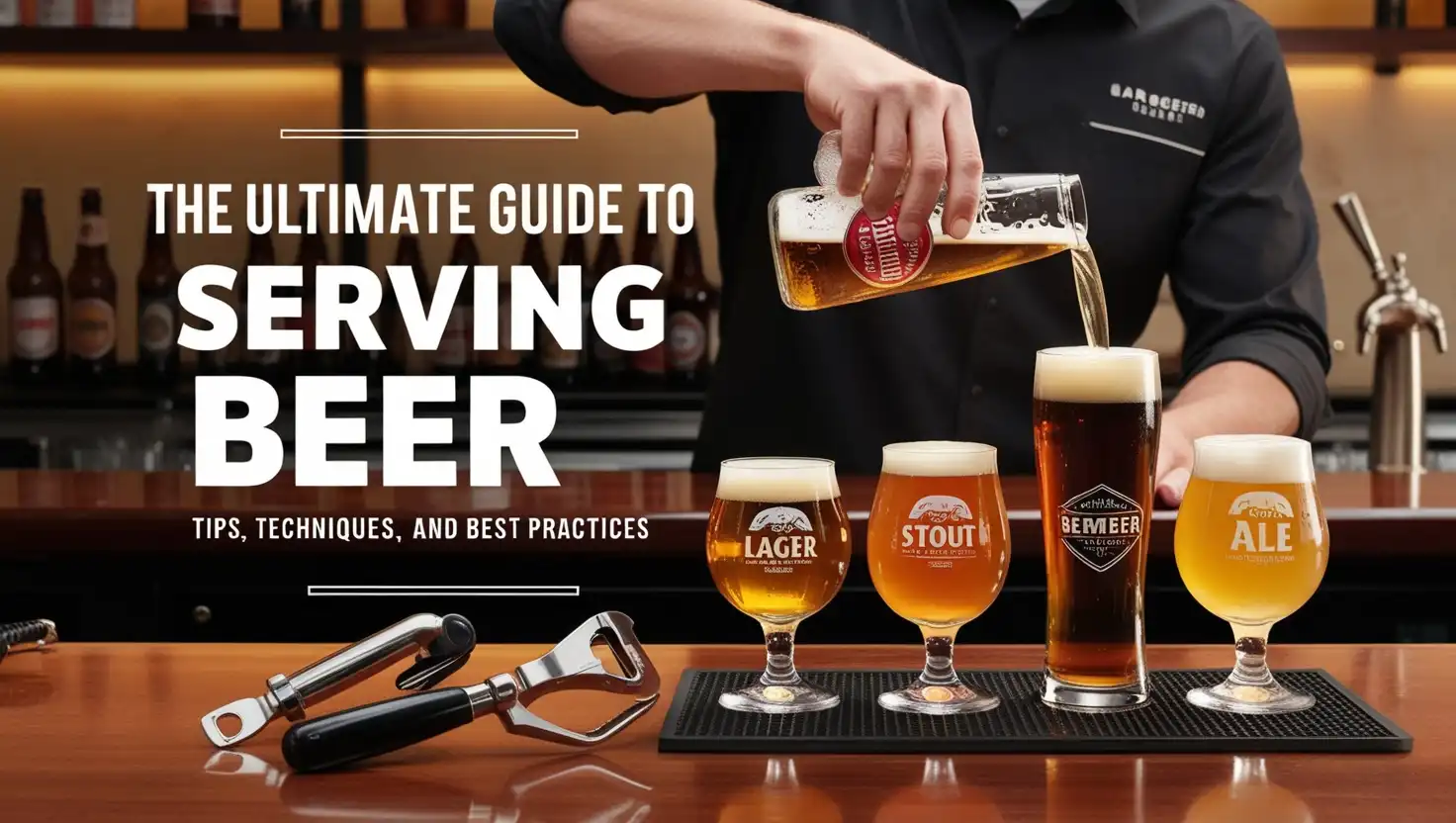Providing a great beer experience requires more than just pouring it into a glass. Whether served in a bustling bar, upscale restaurant, or casual brewery, the art of beer service is an essential skill for anyone in the beverage industry.
This comprehensive guide covers everything from selecting the right glassware to mastering pour techniques, maintaining cleanliness, and enhancing guest interactions, ensuring every customer enjoys their beer as it was intended.
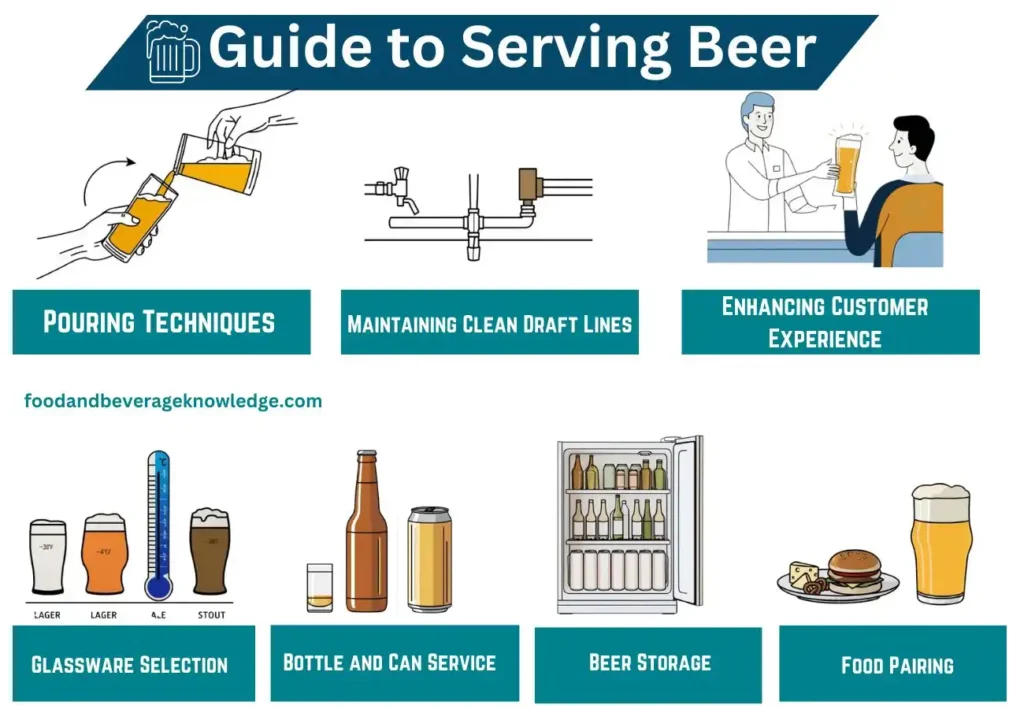
1. Glassware Selection and Preparation
Choosing the right glassware enhances not only the beer’s appearance but also its aroma and flavour. The glass shape influences how aromas are directed toward the nose and affects the beer’s head retention.
- Common Glass Types and Their Uses:
- Pint Glasses: Ideal for a variety of ales and lagers due to their simplicity.
- Tulips and Snifters: Commonly used for aromatic beers like Belgian ales, enhancing the bouquet and concentration of aromas.
- Weizen Glasses: Tall and narrow, perfect for wheat beers, encouraging a tall head and showcasing their cloudy appearance.
- Preparing Glassware:
- Always start with a clean, residue-free glass to avoid impacting the beer’s head and flavour.
- Chill glasses for certain types of beer, but avoid frosted glasses, as over-chilling can dull flavour.
- Rinse each glass with cold water before pouring to reduce friction, keeping carbonation steady.
For further details, check the Wikipedia entry on Beer Glassware.”
Also Read our guide on : 15 Different Types of Beer Glasses: Size, Styles, and Why They Matter
2. Pouring Techniques for Various Beer Types
Pouring is a craft that, when done right, brings out the best in a beer. Different techniques depend on beer style and carbonation levels.
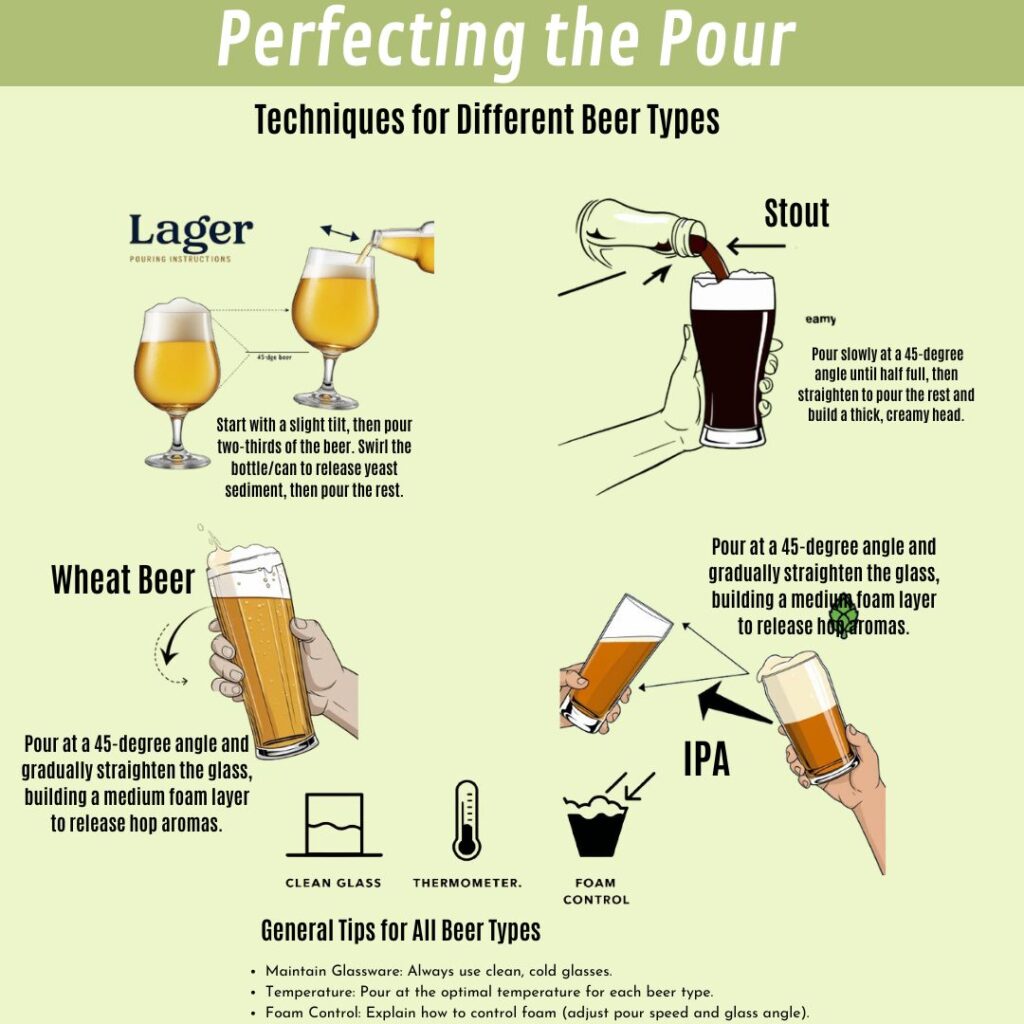
- Basic Pouring Technique: Begin by holding the glass at a 45° angle and pour down the side. Gradually straighten the glass midway to create a foam head that traps aromas.
- For High-Carbonation Beers: Beers like wheat or Belgian ales require slightly more foam. Adjust the pour to encourage a thicker head without overflow, releasing aromas without diminishing carbonation.
- Creating the Right Foam Head: A proper foam head is crucial as it releases aromas and enhances the visual appeal. For most beers, aim for a 1-2 inch foam head. This slight layer of foam captures aromas while softening the initial bitterness, ideal for a well-rounded drinking experience.
Learn more from londonbeercompetitione’s guide on how to pour beer.”
3. Beer Storage and Temperature Control
Correct storage and serving temperatures are essential to maintaining the intended taste, aroma, and mouthfeel.

- Storage Best Practices: Keep beers in a cool, dark place, as sunlight and temperature fluctuations can cause off-flavours. Store beers upright to minimize contact with bottle sediment.
- Temperature at Service:
- Lagers: Serve around 38–45°F to preserve crispness.
- Ales: These can be served slightly warmer at 45–55°F, allowing more complex flavors to emerge.
- Stouts and Porters: Best served close to cellar temperature (50–55°F) to release richer, roasted flavours.
4. Maintaining Clean Draft Lines

The condition of draft lines greatly affects beer quality. Contaminants in the line can spoil flavors, so cleanliness is crucial.
- Cleaning Frequency: Professional standards recommend cleaning lines every two weeks. This helps to remove buildup, including yeasts and bacteria, which can alter taste.
- Daily Maintenance: Flush and rinse taps and couplers with water at the start and end of the day to maintain line cleanliness and prevent microbial growth.
5. Enhancing Customer Experience

Customer service is an integral part of the beer experience. Engaging customers and making recommendations can add value to their visit.
- Educating Staff: Train staff to be knowledgeable about beer types, tasting notes, and food pairings. Well-informed servers can guide customers, enhancing their enjoyment and satisfaction.
- Tailoring Service to Guest Preferences: Recognize that some guests may want to explore different beer styles, while others may seek straightforward service. Flexibility and attentiveness are key.
6. Key Considerations for Bottle and Can Service
While the draft is preferred in many settings, bottle and can service can also provide a quality experience when handled with care.
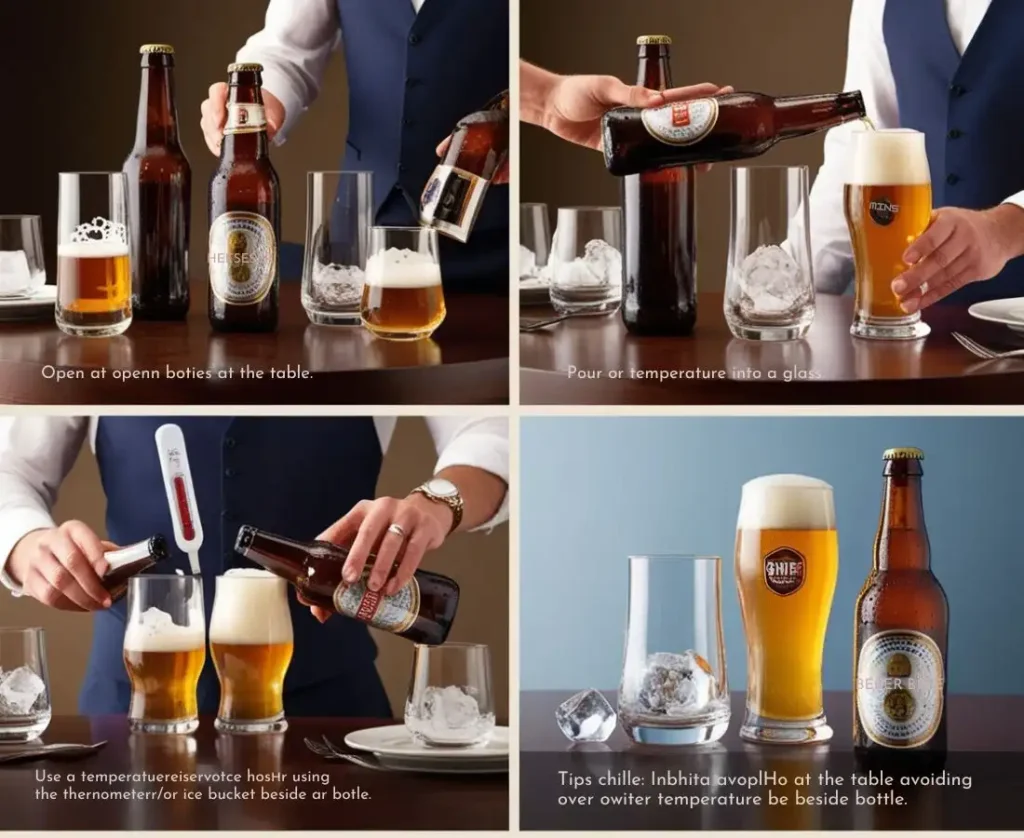
- Bottle Service: For a polished presentation, place the unopened bottle on the table and offer the option to pour it into a glass. For higher-end service, open the bottle tableside and pour gently.
- Avoiding Over-Chilling: Beer served too cold dulls its flavour, so refrain from placing bottles or cans directly on ice. Instead, chill them beforehand and serve at their optimal temperatures.
7. Food Pairing Tips for Beer Service
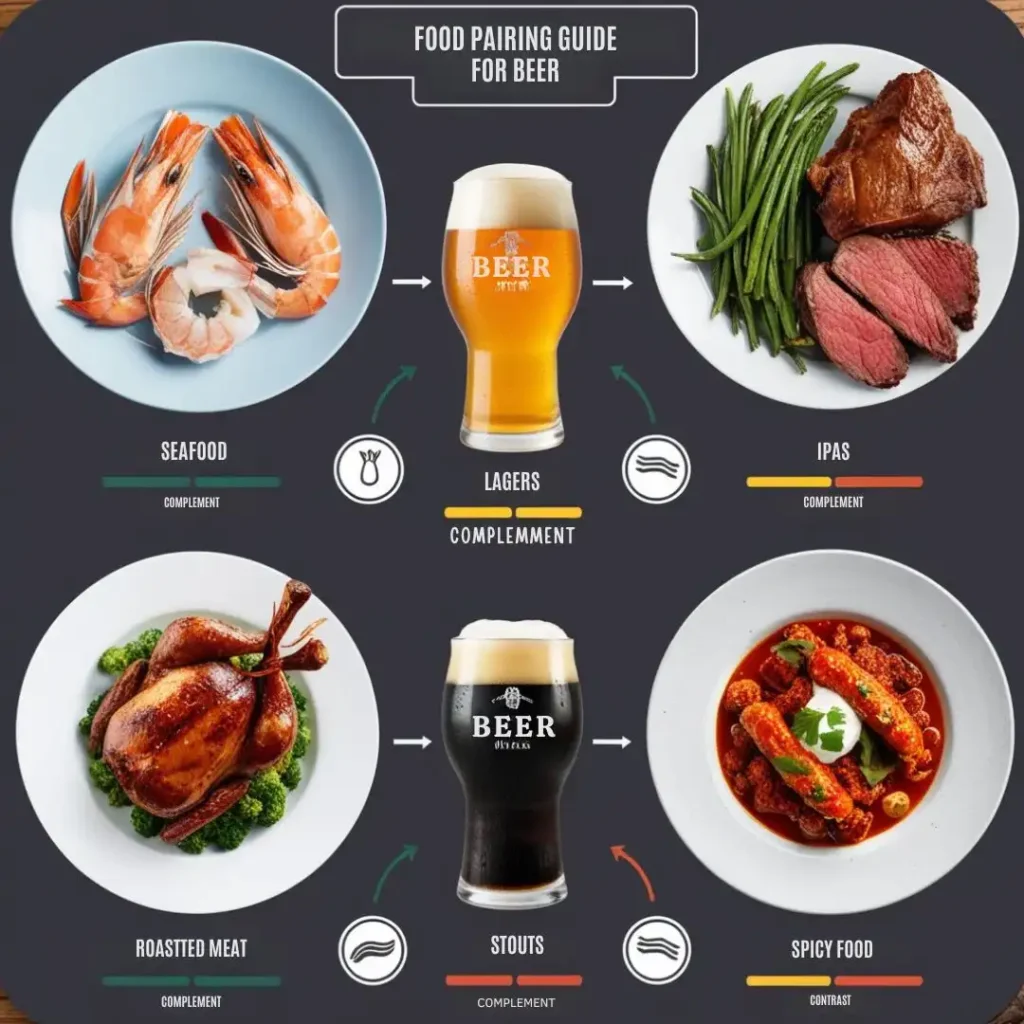
Pairing beer with food enhances both elements, creating a balanced and enjoyable meal.
- Complementary Pairings: Light beers, such as lagers, pair well with seafood and salads, while darker beers, such as stouts, are best with rich dishes like roasted meats and desserts.
- Contrasting Pairings: Bold choices, like pairing an IPA with spicy foods, create dynamic flavor contrasts that elevate the dining experience. The bitterness of the IPA cuts through the spice, creating a balanced profile.
You may also check out the Complete Guide on The Ultimate Beer and Food Pairing Guide: The Best Match for Every Beer Type
Conclusion
Serving beer with care and expertise creates memorable experiences for patrons and sets your establishment apart. By mastering glassware selection, pouring techniques, and customer engagement, you’ll deliver beers at their best, providing a superior drinking experience.
FAQ: service of beer
What is the ideal temperature for serving different types of beer?
Different beers have ideal serving temperatures; lagers, for example, are best served colder than stouts.
Why is glassware important when serving beer?
The right glassware enhances a beer’s aroma, flavour, and presentation, enriching the overall experience.
How should beer be stored to maintain freshness?
Beer should be stored in a cool, dark place to retain its flavor and prevent spoilage.
What’s the proper technique for pouring beer?
Pouring at a 45-degree angle minimizes foam and preserves carbonation, enhancing the beer’s flavor profile.
More On Beer:
- What are the different types of beer?
- 15 Different Types of Beer Glasses
- 13 Popular Beer Brands in India
- Top 13 Most Popular Beer Brands in the World
- Beer Glasses: The Ultimate Guide to Choosing the Right Glassware
- How Beer is Made: A Detailed Step-by-Step Guide
- The Ultimate Guide to Draft & Draught Beer
Subscribe and join our community of hospitality professionals & students — get insights, tips, and the latest updates delivered straight to your inbox!

